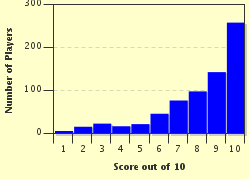Quiz Answer Key and Fun Facts
1. In cricketing terms what is a leg stump?
2. Which of these is not a recognised fielding position?
3. If the fielding side believe that the batsman is out 'stumped', to whom do they make an appeal?
4. Which of these is not something a wrist-spinner would deliver?
5. What is a long-hop?
6. What does it mean when the umpire calls "over"?
7. Many cricketers have superstitions. Australians tend to be wary of the number 87 because it is 13 short of 100. English cricketers are more suspicious of the number 111. What is this number known as?
8. Which of these is not a recognised batting stroke?
9. What is a return crease?
10. What is the umpire signalling if he raises both hands above his head?
Source: Author
mutchisman
This quiz was reviewed by FunTrivia editor
Nightmare before going online.
Any errors found in FunTrivia content are routinely corrected through our feedback system.

